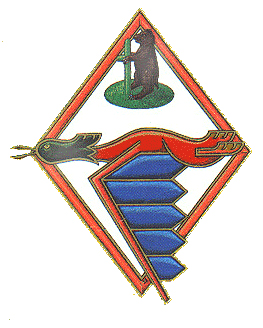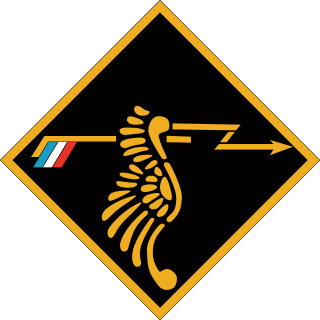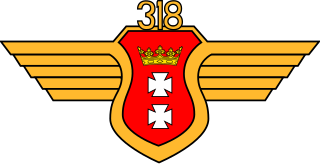
In World War II, the Polish armed forces were the fourth largest Allied forces in Europe, after those of the Soviet Union, United States, and Britain.[a] Poles made substantial contributions to the Allied effort throughout the war, fighting on land, sea, and in the air.

The Fairey Battle is a British single-engine light bomber that was designed and manufactured by the Fairey Aviation Company. It was developed during the mid-1930s for the Royal Air Force (RAF) as a monoplane successor to the Hawker Hart and Hind biplanes. The Battle was powered by the same high-performance Rolls-Royce Merlin piston engine that powered various contemporary British fighters such as the Hawker Hurricane and Supermarine Spitfire. As the Battle, with its three-man crew and bomb load, was much heavier than the fighters, it was therefore much slower. Though a great improvement over the aircraft that preceded it, its relatively slow speed, limited range and inadequate defensive armament of only two .303 (7.7 mm) machine guns left it highly vulnerable to enemy fighters and anti-aircraft fire.

No. 303 Squadron RAF, also known as the 303rd "Tadeusz Kościuszko Warsaw" Fighter Squadron, was one of two Polish squadrons that fought during the Battle of Britain along with No. 302 Squadron, of 16 total Polish squadrons during the Second World War. Flying Hawker Hurricanes, the squadron claimed the largest number of aircraft shot down of the 66 Allied fighter squadrons engaged in the Battle of Britain, even though it joined the fray two months after the battle had begun.

The Polish Air Forces was the name of the Polish Air Forces formed in France and the United Kingdom during World War II. The core of the Polish air units fighting alongside the Allies were experienced veterans of the 1939 invasion of Poland. They contributed to the Allied victory in the Battle of Britain and Allied air operations during the war.

No. 315 Polish Fighter Squadron was a Polish fighter squadron formed in Great Britain as part of an agreement between the Polish Government in Exile and the United Kingdom in 1941. It was one of 15 squadrons of the Polish Air Force in exile that served alongside the Royal Air Force (RAF) in World War II. It was named after the city of Dęblin, where the main Polish Air Force Academy has been since 1927.

No. 138 Squadron RAF was a squadron of the Royal Air Force that served in a variety of roles during its career, last disbanded in 1962. It was the first 'V-bomber' squadron of the RAF, flying the Vickers Valiant between 1955 and 1962.

No. 316 "City of Warsaw" Polish Fighter Squadron was a Polish fighter squadron formed in Great Britain as part of an agreement between the Polish Government in Exile and the United Kingdom in 1941. It was one of 15 squadrons of the Polish Air Force in exile that served alongside the Royal Air Force (RAF) in World War II.

No. 301 Polish Bomber Squadron "Land of Pomerania" was a Polish Air Force squadron formed in Great Britain as part of an agreement between the Polish government-in-exile and the United Kingdom in 1940. It was one of 15 squadrons of the Polish Air Force in exile that served alongside the Royal Air Force in World War II. It was a bomber unit from 1940 to 1943, and special duties squadron from 1944 until it was disbanded in 1946. It operated from RAF airfields in the United Kingdom and Italy.

No. 304 Polish Bomber Squadron was a Polish bomber squadron formed in Great Britain as part of an agreement between the Polish Government in Exile and the United Kingdom in 1940. It was one of 15 squadrons of the Polish Air Force in exile that served alongside the Royal Air Force in World War II. It operated under RAF operational command, and flew from airbases in the United Kingdom. It served from April 1941 as a bomber unit in RAF Bomber Command; from May 1942 as an anti-submarine unit in RAF Coastal Command; and from June 1945 as a transport unit in RAF Transport Command.
No. 305 Polish Bomber Squadron "Ziemia Wielkopolska" was a Polish bomber squadron formed in Great Britain as part of an agreement between the Polish Government in Exile and the United Kingdom in 1940. It was one of 15 squadrons of the Polish Air Force in exile that served alongside the Royal Air Force in World War II. It operated under RAF operational command, and flew from airbases in the United Kingdom.

No. 306 "Toruń" Polish Fighter Squadron was a Polish fighter squadron formed in Great Britain as part of an agreement between the Polish Government in Exile and the United Kingdom in 1940. It was one of 15 squadrons of the Polish Air Force in exile that served alongside the Royal Air Force in World War II.
The Royal Air Force (RAF) and Fleet Air Arm had included personnel from outside the United Kingdom from before the beginning of the Second World War, and many served in the Battle of Britain in summer 1940. Many of these volunteers were British subjects—thus, citizens—coming from territories that made up part of the British Empire. Additionally, a significant part was made up of refugees and exiles from German-occupied Europe and American emigrants.

No. 307 (Polish) Squadron, also known as No. 307 Squadron was a Polish squadron formed in Great Britain as part of an agreement between the Polish Government in Exile and the United Kingdom in 1940. It was one of 15 squadrons of the Polish Air Force in exile that served alongside the Royal Air Force in World War II. It was the only Polish night fighter squadron in RAF service. It was named after the Polish city of Lwów, and was nicknamed "Eagle Owls".

The Polish Armed Forces in the West refers to the Polish military formations formed to fight alongside the Western Allies against Nazi Germany and its allies during World War II. Polish forces were also raised within Soviet territories; these were the Polish Armed Forces in the East.

No. 317 "City of Wilno" Polish Fighter Squadron was a Polish fighter squadron formed in Great Britain as part of an agreement between the Polish Government in Exile and the United Kingdom in 1941. It was one of 15 squadrons of the Polish Air Force in exile that served alongside the Royal Air Force in World War II.

No. 309 "Land of Czerwień" Polish Fighter-Reconnaissance Squadron was a Polish squadron formed in Great Britain as part of an agreement between the Polish Government in Exile and the United Kingdom in 1940. It was one of 15 squadrons of the Polish Air Force in exile that served alongside the Royal Air Force (RAF) in World War II. It was at first a reconnaissance squadron, and later converted into a fighter squadron. It was named after the region around the city of Czerwień; which was then in southeastern Poland, and is now in western Ukraine.

No. 308 "City of Kraków" Polish Fighter Squadron RAF was a Polish fighter squadron formed in Great Britain as part of an agreement between the Polish Government in Exile and the United Kingdom in 1940. It was one of 15 squadrons of the Polish Air Force in exile that served alongside the Royal Air Force in World War II.

No. 318 "City of Gdańsk" Polish Fighter-Reconnaissance Squadron (Polish: 318 Dywizjon Myśliwsko-Rozpoznawczy Gdański") was a Polish tactical reconnaissance aircraft squadron formed in Great Britain as part of an agreement between the Polish Government in Exile and the United Kingdom in 1940. It was one of 15 squadrons of the Polish Air Force in exile that served alongside the Royal Air Force (RAF) in World War II.
Tadeusz Arentowicz was a Polish fighter pilot and ace during the Second World War. He served as a flight lieutenant in the Royal Air Force in the No. 303 Polish Fighter Squadron. He was B-group Flight Commander of the squadron. A week after his final promotion, in 1941, he was on a mission escorting bombers when his plane was shot down by a German fighter near Dunkirk over the English Channel; he was never found.
















